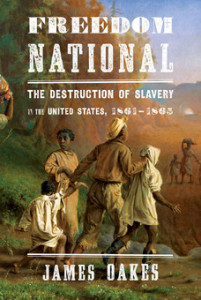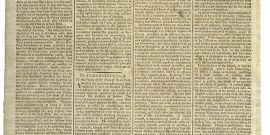For all his contributions to the convention, Madison was not put on the Committee on Detail that provided the penultimate draft of our fundamental law.
The South Was Right, the Historians Are Wrong: Taking the Antislavery Origins of the Civil War Seriously
Why did the Southern states choose to secede when Abraham Lincoln was elected President in November of 1860? At the time, Southerners attributed “secession winter” to the fear that Lincoln and the Republicans fully intended to make war on slavery, bypassing the Constitution, which left the issue of slavery to the states. Thus, they believed, their only option was to separate from the Union.
Northern Democrats agreed, contending that Republicans intended to circumvent the Constitution’s prohibition against direct federal action against slavery. Agitation by the “Black Republicans” was responsible for the crisis. The Democrats felt vindicated when Republicans refused to compromise on the extension of slavery into the territories. In addition, the Democrats charged, the Republicans intended to refuse to enforce the fugitive slave law that had been passed in 1850 as part of the Great Compromise.
No serious historian still denies that the Southern states seceded in order to protect slavery but most argue that Lincoln and the Republicans entered upon war with no intention of attacking slavery, noting that Lincoln said so himself. According to the standard narrative, the Union turned to emancipation only reluctantly as a means to advance the Union war effort.
Of course, they are correct to point out that the Republicans denied any intention to interfere with slavery where it existed. Lincoln addressed the point directly in his inaugural speech. But it is also true that he would brook no compromise on the extension of slavery. As he wrote to James T. Hale on January 11, 1861:
We have just carried an election on principles fairly stated to the people. Now we are told in advance, the government must be broken up, unless we surrender to those we have beaten, before we take the offices…[I]f we surrender, it is the end of [the Republican Party] and of the government. They will repeat the experiment upon us ad libitum. A year will not pass, till we shall have to take Cuba as a condition upon which they will stay in the Union.
Many historians have concluded that if the North was not motivated by any substantial antislavery convictions, then the Civil War cannot be justified morally. Why fight a war the purpose of which was only to restore the Union if emancipation was only an accidental byproduct?
In his remarkable new book, Freedom National: The Destruction of Slavery in the United States, 1861-1865, James Oakes argues that the historians who deny the antislavery origins of the war are mistaken. He contends that from the outset, Republicans had slavery in their sights. Southerners understood that the antislavery threat to the South was real. Accordingly, secession was not an hysterical overreaction to Lincoln’s election but an understandable response to the fact that an antislavery majority in the North had elected an antislavery President. And indeed, Oakes contends, from the very beginning of the conflict, the Republicans worked assiduously to destroy slavery. The problem with the dominant narrative, he argues, is that too many historians have refused to take the Republicans at their word.
Oakes expands the work of Allen Guelzo, who in Lincoln’s Emancipation Proclamation: The End of Slavery in America, argued that from the first day of his presidency, Lincoln had his eye firmly set on ending slavery. Oakes takes nothing away from Lincoln, but demonstrates that Lincoln’s approach was reflective of the Republican Party as a whole. While there were many differences between Lincoln and the Radicals within the Republican Party, they were of far less import than those between the Democrats and the Republicans. As Lincoln himself once remarked, the difference between Charles Sumner, the Radical Republican senator from Massachusetts, and himself was six weeks.
The Republican Party grew out of the anger generated in both the Whig and Democratic Parties by the Kansas-Nebraska Act of 1854, which repealed the Missouri Compromise prohibiting the expansion of slavery into the territories formed out of the old Louisiana Purchase that lay north of Missouri. But the Republicans inherited a coherent set of antislavery principles formulated long before the Nebraska controversy. Oakes traces the evolution of this antislavery consensus and shows how it shaped the policies of the Lincoln administration and Congress toward slavery once the war began.
The antislavery consensus that underpinned the Republican Party was based on a number of principles: 1) The Founding generation suffused the Constitution with the principles of natural law and the law of nations, which held that man’s natural condition is freedom: the Constitution is inseparable from Declaration of Independence. 2) The presumption of freedom recognized by the Constitution could be overridden only by local or municipal law—in other words freedom was “national,” holding sway wherever the Constitution was sovereign, for example in the federal territories and on the high seas, while slavery was “local,” limited to state jurisdiction. 3) While the Constitution placed slavery in the states where it existed beyond the reach of the federal government, the Constitution did enable the Federal Government to limit the expansion of slavery. 4) The slavery compromises of the Federal Constitution never included the idea that slaves were property—there could be no such thing as “property in man. ”
Republicans firmly believed that these principles provided the basis for a federal assault on slavery once Lincoln and a Republican Congress took office, notwithstanding the fact that the Constitution prohibited the federal government from interfering with slavery in the states where it existed. Just as Southern secessionists and Northern Democrats had argued, Republicans intended to ban slavery from all the Western territories, abolish slavery in Washington, D.C., withdraw federal protection of slavery on the high seas, and deny admission to any new slave states. Many Republicans, if not necessarily Lincoln, also intended to prohibit federal enforcement of the fugitive slave clause of the Constitution.
If the slave states remained in the Union, Republicans believed that this approach would permit the federal government to construct a “cordon of freedom” around the slave states that would bring about what Lincoln called the “ultimate extinction” of slavery. They assumed that because slavery was intrinsically weak this cordon of freedom would ultimately strangle slavery, forcing the slave states themselves to abolish the institution on their own.
The Republican logic of 1860 held that abolition would begin in the northernmost slaves states—Delaware, Maryland, Kentucky, and Missouri—where slavery was weakest. As more free states joined the Union and as more slave states abandoned the institution, slavery would wither and die. Despite Southern objections, Republicans contended that such a policy did not violate the Constitution’s ban on direct federal “interference” with slavery in the states where it already existed.
But secession by the slave states opened the way for another means to attack slavery: immediate, uncompensated military emancipation in the disloyal states, justified under the war powers of the Constitution. For many years, the official U.S. position had been just the opposite. While European writers such as Emmerich de Vattel and Jean-Jacques Burlamaqui argued that it was permissible to seize the private property of the enemy during wartime, Americans had demurred, arguing that it was impermissible for an enemy to seize private property, especially slaves, contending that to do so was to incite servile insurrection.
Indeed, John Quincy Adams had made precisely this argument when he was secretary of state during the Monroe administration, demanding that the British return slaves they had emancipated during the War of 1812. But his views changed. Adam’s argument before the Supreme Court in the Amistad case became the basis for the idea that although the federal government could not abolish slavery in a state, it could emancipate slaves in any state that was in rebellion against the United States.
Thus, states that remained loyal during the Rebellion would be provided the opportunity to accept peaceful, gradual, compensated abolition of slavery. But secession meant a war of rebellion, and such a war meant immediate, uncompensated military emancipation. Although Republicans understood that the only constitutional justification for prosecuting the war was to restore the Union, they also recognized that the effect of the war would be the destruction of slavery, an outcome that they welcomed. Of course, they understood that military emancipation had its limits: although it could free individual slaves, it could not end slavery itself.
Oakes demonstrates how the Lincoln administration, Congress, the War Department, and the slaves themselves worked in tandem from the very beginning of the war to attack slavery. Indeed, the Republican’s antislavery policy was based on the assumption that the slaves hated slavery and would take advantage of the war to claim their freedom. Hundreds of thousands did.
The Union attack on slavery began as early as May of 1861 with Major General Benjamin Butler’s contraband policy and continued with the passage of the two confiscation acts passed by Congress in 1861 and 1862, Lincoln’s Emancipation Proclamation, and the enlistment of black soldiers in the Union army. It culminated with the passage of the Thirteenth Amendment to the Constitution, which finally drove a stake through the heart of the institution.
As noted above, Republicans had always believed that emancipation would occur first in the loyal slave states and that this dynamic would put pressure on the rebelling states. Oakes argues that in fact the reverse was the case. As Oakes notes, the loyal slave states resisted federal pressure against slavery rather than quickly surrendering to abolition. By 1862 Lincoln and the Republicans in Congress were losing patience with the loyal slave states and by 1863 the Union army was actively impressing slaves from loyal masters in these states and guaranteeing the freedom of enlistees from the loyal slave states, as well as that of their families.
When the war began, Republicans believed that slavery was inherently weak and that it would collapse under the twin pressures of voluntary emancipation in the loyal slave states and military emancipation in the Rebel states. But as Frederick Douglass observed, slavery was “the stomach” of the rebellion and indeed, it proved hard to overcome, especially once the South instituted a “counter-revolution of property” policy that was severe, violent, and bloody in response to the federal attack on slavery. Thus there were limits to what military emancipation could accomplish.
Lincoln’s reelection in 1864 ensured that the Union would be restored but not necessarily that slavery would be destroyed. Republicans believed that neither military emancipation nor state abolitionism would be enough to end slavery. That would require a constitutional amendment. Given the increased Republican majorities in both houses of Congress, passage of such an amendment would be assured when the Thirty-Ninth Congress (elected in November of 1864) opened in December of 1865, but Lincoln and the Republicans feared that if the war ended before abolition was secure, the Democrats’ charge that the Republicans had always used “military necessity” as an excuse to mask their “fanatical determination to destroy slavery” would seem to be validated. If Republicans continued to press for abolition once peace was restored, they would lose their most politically potent justification for the amendment. This accounts for the push to have the Thirty-Eighth Congress pass the amendment in January of 1865.
Oakes’s great achievement is to demonstrate that Lincoln and the Republican Party adopted a strong antislavery policy from the beginning of the secession crisis and advanced it as the war progressed. It is important to remember that emancipation did not begin on January, 1863. It had been underway since May of 1861, a mere month after the rebellion began. Lincoln was hardly a “reluctant” emancipator, but neither did he act entirely on his own, but always in accordance with the principles of the Republican Party.
Today we often act as if the destruction of slavery in the United States was inevitable. But as Oakes makes clear, slavery was too strong to be destroyed by the war alone, as the Republicans believed in 1861. It took not only a full-scale war but also a constitutional amendment to finally destroy it. No one could be reasonably sure that would happen until Lincoln and the Republicans won the elections in November of 1864.


